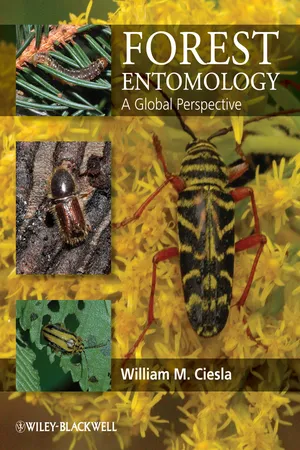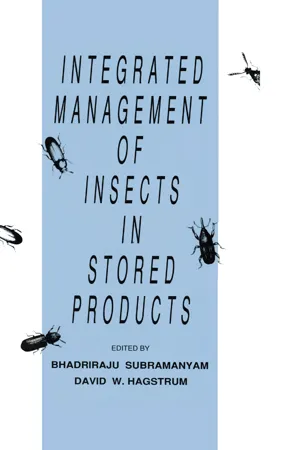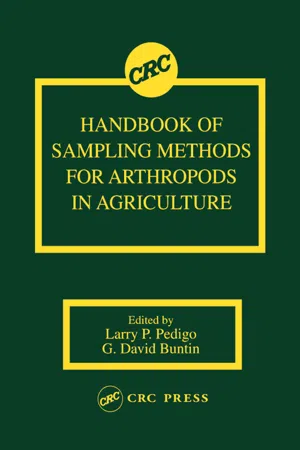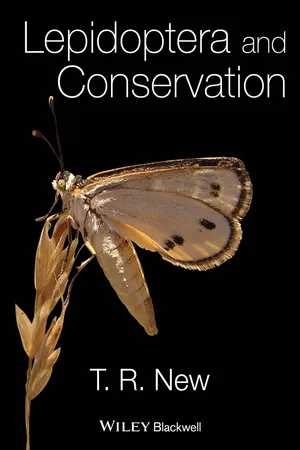Geography
Insect Sampling
Insect sampling is the process of collecting and analyzing insects in a particular area. This is done to study the diversity, abundance, and distribution of insect populations. Different methods of insect sampling include sweep netting, pitfall trapping, and light trapping.
Written by Perlego with AI-assistance
Related key terms
Related key terms
1 of 4
Related key terms
1 of 3
5 Key excerpts on "Insect Sampling"
- eBook - ePub
- David Held(Author)
- 2019(Publication Date)
- Academic Press(Publisher)
Chapter 5Sampling insects and decision-making
Abstract
Sampling (a.k.a. scouting) is the only way to know the abundance, location, and timing of activity of insects and mites in urban landscapes. In Chapter 2 , you learned the terms density and distribution as important descriptions for populations. All sampling and eventual pest management decisions are made at the population level. Sampling techniques for pests and beneficial insects in urban landscapes are not expensive or difficult yet they are not commonly used. This may be due to several reasons; outbreaks are not as predictable as problems with annual or perennial weeds, insecticides on average are less expensive than fungicides or herbicides, and plant professionals typically do not know how to sample. In urban landscapes, insects and mites can be found above the ground, in the soil, or inside the plant (e.g., leafminers, borers). In the following sections, you will learn the common methods for sampling arthropods in the landscape and what you could do with that information once you have it. The resources section at the end of this chapter provides a list of sources for sampling equipment and links to online resources for sampling.Keywords
Aesthetic injury level; Damage; Integrated pest management; Sampling; SymptomsSampling (a.k.a scouting) is the only way to know the abundance, location, and timing of activity of insects and mites in urban landscapes. Chapter 2 , introduced the terms density and distribution as important descriptions for populations. All sampling and eventual pest management decisions are made at the population level. Sampling techniques for pests and beneficial insects in urban landscapes are not expensive or difficult, yet they are not commonly used. This may be due to several reasons; outbreaks are not as conspicuous as problems with annual or perennial weeds, insecticides on average are less expensive than fungicides or herbicides, and plant professionals typically do not know how to sample. In urban landscapes, insects and mites can be found above the ground, in the soil, or inside the plant (e.g., leafminers, borers). In the following sections, you will learn the common methods for sampling arthropods in the landscape (Box 5.1) - eBook - ePub
Forest Entomology
A Global Perspective
- William Ciesla(Author)
- 2011(Publication Date)
- Wiley-Blackwell(Publisher)
Obviously, it is physically impossible to count all of the insects on a hectare of forest land or even on an individual tree. Therefore sampling schemes are developed to provide reliable estimates of insect numbers that meet objectives of the monitoring. Development of effective methods of insect population sampling requires knowledge of the insect, its biology and ecology as well as some basic knowledge of statistics and sampling design.Considerations Once the objectives of the monitoring have been identified, the following considerations are addressed in development of protocols for sampling an insect population:- sample unit (e.g. tree, branch, bole or trap);
- sample size;
- where to sample;
- when to sample;
- how often to sample.
- branches of a given length on which numbers of eggs, egg masses or larvae are counted;
- sections of bark of known area on which counts of bark beetle life stages are made;
- leaves on which counts of aphids or scales are made;
- branches containing cones or fruits to estimate levels of infestation by insects that attack reproductive structures;
- entire trees (seedlings or saplings);
- an area of soil or litter surface to estimate numbers of cocoons or pupae.
Selection of the sample unit for a given insect is defined by a combination of the biology and habits of the insect and where it is practical to draw the sample. Branch samples are often used for estimating population densities of defoliators. They are also effective sample units if the insect deposits its eggs on branches. Sections of bark of known size are logical sample units for estimating population densities of bark beetles or for insects that deposit their eggs or egg masses on the bark surface of host trees. Use of whole trees as a sample unit is limited to small trees, usually less than 3 m tall and where insect densities are relatively low or are concentrated in colonies.Insect numbers are expressed relative to the sample unit. Population densities of defoliators, for example, are expressed as numbers of eggs, egg masses or larvae per branch of given length or per unit area of foliage surface. Numbers of bark beetles are expressed as insects per square meter of bark surface. Densities of aphids or scales can be expressed as insects or insect colonies per leaf or per branch of known size. In cases where whole trees can serve as the sample unit, insect densities are expressed as numbers of egg masses, larvae or colonies of larvae per tree. - Bhadriraju Subramanyam(Author)
- 2018(Publication Date)
- CRC Press(Publisher)
Sampling should also be used to determine whether control measures were successful, by comparison of pre- and posttreatment counts or presence/absence of insects in the samples. However, it is important to bear in mind that after applying control measures a majority of the insects are killed, and the density and spatial structure of insects in the sampling universe may be altered. Therefore, the number of samples needed to estimate the posttreatment density reliably may be different from the number of samples needed to estimate the pretreatment density.XI. SUMMARY
In most agricultural situations, sampling the entire sampling universe to determine a population attribute (mean density or proportion) is impossible or cost-prohibitive. Therefore, these population parameters are unknown. Thus, samples of a known size are removed from the sampling universe to make inferences about these population parameters. Designing a sampling program involves choosing an appropriate sample unit, determining the number of samples to use, selecting locations to be sampled, and the time of sampling. Small sample units are often more efficient than large sample units, but the costs associated with obtaining the samples are higher for the former than the latter. Sample locations should be selected to provide a representative sample. Samples must be taken frequently to detect insect populations before they reach unacceptable levels. Sampling methods that provide absolute estimates are generally needed for studying insect ecology, but for pest management less accurate estimates of insect density may be considered to reduce sampling costs. However, it is important to establish a relationship between relative density estimates and absolute pest density estimates or damage.Mapping the location of insects within the sampling universe is difficult, especially if the insects are mobile or active. Therefore, information from the sample units is used to describe the spatial distribution or sampling distribution of the insect populations. Fitting probability distribution functions or dispersion indices to sampling data permits development of sampling plans for estimation or decision-making in pest management (Binns and Nyrop 1992). A few sampling plans, for estimating insect density, have been developed for stored-product insects (Hagstrum et al. 1985; Hodges et al. 1985; Subramanyam and Harein 1990; Subramanyam et al. 1993). We hope researchers and pest managers working with stored-product insects will use the sampling concepts and formulas presented in this chapter to develop sampling plans for cost-effective management of insect pests. The four basic pieces of information needed to use the numerous equations presented in this chapter are the mean, variance, number of samples used to estimate the sample mean and variance, and proportion of sample units with insects. Most of the computations are easy and can be done on a hand calculator, while fitting a few models or equations to sample data may require the use of a computer. Most of the equations have been illustrated using examples based on published and unpublished stored-product Insect Sampling data. Numerous references have been provided for those interested in additional information not covered in this chapter. Sampling is an integral component of integrated pest management. The business of storing, processing, and distributing food products can be more profitable if pest management decisions are based on practical sampling programs that provide precise estimates of population density or proportion.- Larry P. Pedigo, G. David Buntin, Larry P. Pedigo, G. David Buntin(Authors)
- 2020(Publication Date)
- CRC Press(Publisher)
4As part of an overall IPM strategy, sampling techniques should be compatible with the objective of the decision maker. For example, if the management situation calls for a binary decision on whether or not to apply a prophylactic suppression tactic, then the sampling technique must provide discrete predictive data within the appropriate time horizon to accommodate the decision. If, however, the situation calls for continuous monitoring to assess population growth and development, then the sampling technique(s) must account for population dynamics and host susceptibility in order to make effective curative control decisions.5 The design and use of arthropod sampling techniques, therefore, helps to enable IPM by providing a means by which to make informed decisions. In addition, because the cost of sampling is integral to the cost (and hence, feasibility) of IPM, every effort should be made to develop a high level of efficiency with the design and use of the technique(s). Otherwise, sampling and subsequent curative control decision making will prove to be a less desirable management alternative, resulting in either overuse or underuse of suppression tactics.6Inasmuch as the challenge of establishing an effective IPM strategy largely is a challenge of developing an effective and efficient sampling technique, the objective of this chapter is to review several basic techniques currently employed for the surveillance and sampling of arthropods. Primary categories include: techniques for surface and above-ground arthropods, techniques for soil arthropods, and techniques for indirect assessment of arthropods. Although reference to, or review of, all adaptations to these primary sampling techniques is not pragmatic, representative examples for categories are provided for illustrative purposes.- eBook - ePub
- T. R. New(Author)
- 2013(Publication Date)
- Wiley-Blackwell(Publisher)
Substantial areas can be inspected, with outcomes linked to habitat category. Correlative records of changes in abundance and distribution of British butterflies, largely from transect walk data (Asher et al. 2001), constitute the most influential compilation of data on any insect fauna. The same procedure is suitable for diurnal moths (Groenendijk & van der Meulen 2004). As Pollard and Yates emphasised, the basic needs for any monitoring or wider survey method are that it is rapid and easy to use in ways that are well defined, standardised and minimise errors, and the approach provides sound information on representation of species and population sizes, so that repetition may reveal trends of change. Transect walk approaches usually confine information to those insects recorded within a (defined) few metres of the transect line. However, if detection at greater distances is straightforward and unambiguous, ‘distance sampling’ may also be relevant to help in assessing densities and population sizes. The method (discussed by Haddad et al. 2008) assumes that the transects are placed randomly with respect to the target Lepidoptera, in turn assuming a uniform density distribution about the transect. Detection at the centre of the transect is then certain, and detection elsewhere is a decreasing function of distance from the central transect line. Conditions for use in estimating population numbers include (1) uniform habitats; (2) high visibility, so that targets are not obscured by dense vegetation or uneven terrain; (3) random transects do not damage habitats, such as by trampling or other disturbance, in contrast to the more usual employment of predetermined regular paths for conventional Pollard walks; and (4) the insects occur in sufficiently large numbers to estimate detection functions. Use of this sampling approach for the conspicuous Regal fritillary butterfly (Speyeria idalia) (Powell et al. 2007, Chapter 13, p
Index pages curate the most relevant extracts from our library of academic textbooks. They’ve been created using an in-house natural language model (NLM), each adding context and meaning to key research topics.
Explore more topic indexes
Explore more topic indexes
1 of 6
Explore more topic indexes
1 of 4




